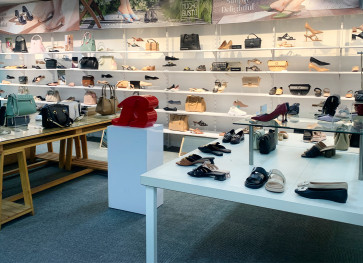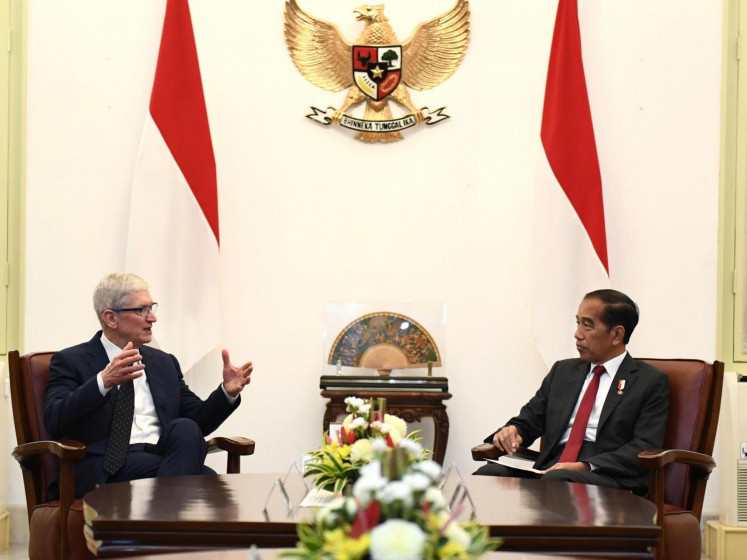Using cashless payments brings big discounts
Since the emergence of cashless payments, more consumers in the capital city have become hyped about moving toward the cashless lifestyle
Change Size

S
span>Since the emergence of cashless payments, more consumers in the capital city have become hyped about moving toward the cashless lifestyle.
Consumers have been using card payments such e-Money by Mandiri and also Flazz by BCA to pay for parking fees, road tolls and other transportation costs. E-wallets such as Go-Pay, OVO and DANA have been used for shopping, purchasing food and buying movie tickets.
Using cashless payment methods can also save a lot of money as vendors often offer big discounts. Many users said they use cashless payments to benefit from discounts offered as promotional campaigns. However, as the vendors cooperate only with certain cashless payment operators, not all customers can benefit from the discounts, except if they have all the cashless applications or electronic payment cards.
For some customers, using different kinds of cashless applications is burdensome as they have to download all the existing apps only so they can benefit from all the available discounts and other promotional rewards.
Timotius Noya, 36, a professional musician from Ambon, Maluku, for example, said it was quite unpractical to use many payment applications to carry out cashless transactions.
“It’s complicated. I regard myself as an efficient type of person. So these varied types of apps are complicated for me.” said Noya told The Jakarta Post on June 10. “It’ll be a lot easier if we can only use one app.”
Noya mentioned how he liked m-banking since it can be used for many purposes such as paying for Go-Food, for parking tickets in some malls and for taking trains or Transjakarta buses.
Users admit it is their choice whether to use only one or two cashless payment applications or most of the applications available in the market.
If they want to be practical, they just use one of two kinds of payment applications, so they do not need to top up many applications, they said.
“I don’t think it’s complicated since top-up can be done via m-banking, so we have platforms supporting one another,” said Asaf Kharisma, a 29-year-old employee from Jakarta.
Meanwhile, Christoforus Vio, a 26-year-old private employee, shared his personal experience of going cashless with the various types of cashless payment methods he uses.
“It really eases everything out, plus it adds more safety since now I no longer bring cash or need to pull out my wallet, everything can be done by using a phone. Plus, there’s so
many cashback [offers] and promotions.” said Vio who uses Go-Pay, OVO, DANA and also Flazz by BCA.
Every month, Vio said he tops up his e-wallets with a fair amount of money: Rp 1 million to his OVO account, Rp 1 million to his Go-Pay and Rp 300,000 to his Flazz.
Responding to both positive and negative comments from consumers, the head of public policy of the Indonesia Fintech Association, Aji Satria, said he regards the increasing phenomenon as a positive sign.
“It’s very positive. What’s more interesting is that non-bank mobile server-based e-money [Go-Pay, OVO, Dana, LinkAja] covers 90 percent of the system, which proves it’s in a unique position, compared to the card-chip based e-money brought by banks [Flazz, e-Toll],” Satria told the Post on Thursday.
“It’s not confusing. Urban people nowadays can have more than one debit or credit card, plus non-card applications, since each have their own benefits or incentives. Let the market and competition move,” Satria said when asked about the confusion resulting from the increasing number of new e-wallet products.
Setiawan Adhiputro, the director of OVO, one of the growing fintech companies in Indonesia, said that the transition toward non-cash payments would benefit all, both consumers and merchants, through the services.
“This year’s target is to improve education about e-money in order to increase cashless transactions,” he added.
Not only merchants, but some malls had also moved toward using non-cash payments for their parking systems. The Lippo Group, for example, uses OVO for parking payments in its malls.
Bank Indonesia (BI) recently launched a long-awaited Quick Response Indonesia Standard (QRIS) code system that aims to universalize cashless payments in the country.
The QRIS, which physically manifests as a more complex QR pattern, allows users from one payment service to transfer funds to any rival service within BI’s ecosystem.
A customer using the LinkAja e-wallet service, for example, could transfer funds to a shopkeeper using the OVO e-wallet if at least one party has a QRIS code. (tkp)









